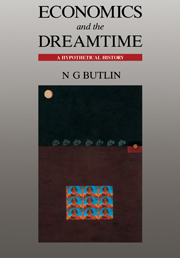Book contents
- Frontmatter
- Contents
- Preface
- Acknowledgements
- Figures
- Maps
- Tables
- Introduction
- Part I The palaeoeconomic history of Aboriginal migration
- 1 Introduction
- 2 Conventional views and alternative approaches
- 3 Non-Malthusian issues: pathways and innovations
- 4 Scarcity possibilities in Aboriginal migration
- 5 Some possible migration scenarios
- 6 A synthesis
- Part II Development, structure and function of Aboriginal economy
- Part III Disease, economics and demography
- Part IV The establishment of a bridgehead economy: 1788–1810
- Part V The takeover process: 1788–1850
- Bibliography
- Appendix 1 Preliminary model/checklist of Aboriginal migration to Australia
- Appendix 2 NOAA depth contour maps
- Index
4 - Scarcity possibilities in Aboriginal migration
Published online by Cambridge University Press: 06 July 2010
- Frontmatter
- Contents
- Preface
- Acknowledgements
- Figures
- Maps
- Tables
- Introduction
- Part I The palaeoeconomic history of Aboriginal migration
- 1 Introduction
- 2 Conventional views and alternative approaches
- 3 Non-Malthusian issues: pathways and innovations
- 4 Scarcity possibilities in Aboriginal migration
- 5 Some possible migration scenarios
- 6 A synthesis
- Part II Development, structure and function of Aboriginal economy
- Part III Disease, economics and demography
- Part IV The establishment of a bridgehead economy: 1788–1810
- Part V The takeover process: 1788–1850
- Bibliography
- Appendix 1 Preliminary model/checklist of Aboriginal migration to Australia
- Appendix 2 NOAA depth contour maps
- Index
Summary
‘Push’ factors
If there were a specific ‘pull’ in terms of production possibilities to encourage potential migrants, were there also ‘push’ factors? Here we have to consider broader economic issues. In principle, these issues might be related in a relatively localised form to the Lesser Sundas or to the islands eastward from Sulawesi. Or one might look further afield. In both cases, we may partly depart from the culture-driven, non-Malthusian world conventionally perceived for the early hunter gatherer and consider possibilities which, if not necessarily fully Malthusian, nevertheless turn on possibilities of population/resource (or population/consumption) issues. In the one case, we might simply see populations expanding or resources dwindling in the Lesser Sundas or east of Borneo. Or we might consider possibilities of new entrants from further afield into these areas, driven themselves in part by population/consumption pressures. These new entrants might or might not have reached Australia/New Guinea. Their role could have been merely to ‘shepherd’, by physical conflict or resource competition, existing groups across the seas; and some of them, in turn, might have been similarly induced to depart. In either case, we need to consider the economic–demographic attitudes of prehistorians, not merely in Australia but also globally.
A first digression: palaeodemography
Demographic analysis is just a little bit more prominent (see, e.g., Hassan, 1981) than economic analysis in the toolkit of prehistorians. At about 120,000 years ago, the global perception is broadly of a tiny world population, subdivided into hunting-gathering bands of an average of forty or so persons, linked culturally into larger groups of about 500 persons.
- Type
- Chapter
- Information
- Economics and the DreamtimeA Hypothetical History, pp. 35 - 41Publisher: Cambridge University PressPrint publication year: 1993



